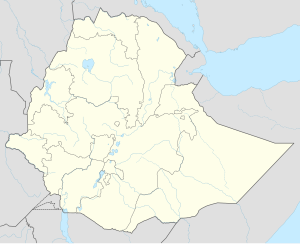Kebri Beyah (woreda)
Kebri Beyah
Qabri Bayax | |
|---|---|
City | |
| Nickname: KB | |
| Coordinates: 9°21′N 42°48′E / 9.350°N 42.800°E | |
| Country | |
| Region | Somali |
| Government | |
| • Type | City Administration Mayor = Khalid Mohamed |
| Elevation | 1,609 m (5,279 ft) |
| Population (2007) | |
| • Total | 165,518 |
| Time zone | UTC+3 (EAT) |
Kebri Beyah (Somali: Qabribayax) is a city and woreda in Somali Region, Ethiopia. Part of the Kebri Beyah is bordered on the south by the Degehabur Zone, on the southwest by the Fiq Zone, on the northwest by Gursum, on the north by Jijiga and Awbare, on the northeast by Somaliland, and on the east by Harshin. The City administrative center is Kebri Beyah City.
The average elevation in this woreda is 1530 meters above sea level.[1] The only perennial rivers in Kebri Beyah are the Fafen and the Jerer. As of 2008[update], Kebri Beyah has 55 kilometers of asphalt road, 48 of all-weather gravel road and 2642 kilometers of community roads; about 13.1% of the total population has access to drinking water.[2]
The Ethiopian De-mining Office reported in November 2008 that it had cleared land mines planted in Kebri Beyah as part of the four million square meters of land the office had cleared in the Somali Region.[3]
Demographics[edit]
Based on the 2007 Census conducted by the Central Statistical Agency of Ethiopia (CSA), this woreda has a total population of 165,518, of whom 89,703 are men and 75,815 women. While 25,493 or 15.4% are urban inhabitants, a further 19,806 or 11.97% are pastoralists. 98.77% of the population said they were Muslim.[4]
There are 16,353 refugees from Somalia living at Kebri Beyah refugee camp.[5]
The 1997 national census reported a total population for this woreda of 162,474, of whom 85,974 were men and 76,500 women; 23,725 or 14.6% of its population were urban dwellers. The largest ethnic group reported in Kebri Beyah was the Somali people with 160,785 or 99.0% of the total population being of Somali origin.[6] The Jidwaq make up the majority of the town.
Refugee camp[edit]
Kebri Beyah has been the site of a refugee camp since 1989.[7] The camp originally housed about 10,000 refugees and returnees from Somalia,[8] It was the only camp in the Somali Region to remain open while the United Nations High Commissioner for Refugees (UNHCR) was able to close down the other camps in the region between 1997 and 2005. By 2005, the UNHCR expected to close the Kebri Beyah camp soon as well.[9] However, the greater influx of refugees from south-central Somalia led to the growth of the camp up to 16,000 or 17,000 inhabitants. In 2007, 4,000 refugees were relocated from Kebri Beyah to Teferi Ber where a former camp was partially re-opened.[10][11]
Agriculture[edit]
A sample enumeration performed by the CSA in 2001 interviewed 17,209 farmers in this woreda, who held an average of 1.15 hectares of land. Of the 19.8 square kilometers of private land surveyed, 75.11% was under cultivation, 11.21% pasture, 12.4% fallow, and 1.29% was devoted to other uses; the area in woodland is missing. For the land surveyed in this woreda, 61.29% was planted in cereals like teff, sorghum and maize, and 0.53% in pulses; the area planted in root crops and vegetables is missing. Permanent crops included 2539 hectares planted in khat, and 41.84 in fruit trees. 88.59% of the farmers both raised crops and livestock, while 4.29% only grew crops and 7.11% only raised livestock. Land tenure in this woreda was distributed amongst 98.02% owning their land, 0.94% renting, and the remaining 1.04% holding their land under other forms of tenure.[12]
Notes[edit]
- ^ Hailu Ejara Kene, Baseline Survey of 55 Weredas of PCDP Phase II, Part I Archived 2011-07-20 at the Wayback Machine (Addis Ababa: August 2008), Annex 1 (accessed 23 March 2009)
- ^ Hailu Ejara Kene, Baseline Survey, Annexes 16, 17
- ^ "Landmines Cleared From 4 Million Square Meters Of Land"[permanent dead link], Ethiopian News Agency, 20 November 2008 (accessed 17 June 2009)
- ^ Census 2007 Tables: Somali Region Archived 2012-11-14 at the Wayback Machine, Tables 2.1, 2.4, 3.1 and 3.4.
- ^ "Horn Refugees in Ethiopia - Ethiopia - Jijiga". Archived from the original on 2016-02-18. Retrieved 2012-10-31.
- ^ 1994 Population and Housing Census of Ethiopia: Results for Somali Region, Vol. 1 Archived 2008-11-19 at the Wayback Machine Tables 2.1, 2.12 (accessed 10 January 2009). The results of the 1994 census in the Somali Region were not satisfactory, so the census was repeated in 1997.
- ^ "IRIN Africa | ETHIOPIA-SOMALIA: New camp opened for Somali refugees | Horn of Africa | Ethiopia Somalia | Conflict Refugees/IDPs | News Item". 2010-08-21. Archived from the original on 2010-08-21. Retrieved 2023-03-29.
{{cite web}}: CS1 maint: bot: original URL status unknown (link) - ^ "Pastoral society and transnational refugees: population movements in Somaliland and eastern Ethiopia 1988 - 2000. New Issues in Refugee Research, Working Paper No. 65" (PDF).
- ^ "IRIN | UNHCR close to phasing out operations in the east". 2018-10-20. Archived from the original on 2018-10-20. Retrieved 2023-03-29.
{{cite web}}: CS1 maint: bot: original URL status unknown (link) - ^ "IRIN | Asylum-seekers living rough". 2018-10-20. Archived from the original on 2018-10-20. Retrieved 2023-03-29.
{{cite web}}: CS1 maint: bot: original URL status unknown (link) - ^ Ethiopia: Somali refugees to be relocated away from border, UNHCR, 13 July 2007
- ^ "Central Statistical Authority of Ethiopia. Agricultural Sample Survey (AgSE2001). Report on Area and Production - Somali Region. Version 1.1 - December 2007"[permanent dead link] (accessed 26 January 2009)

